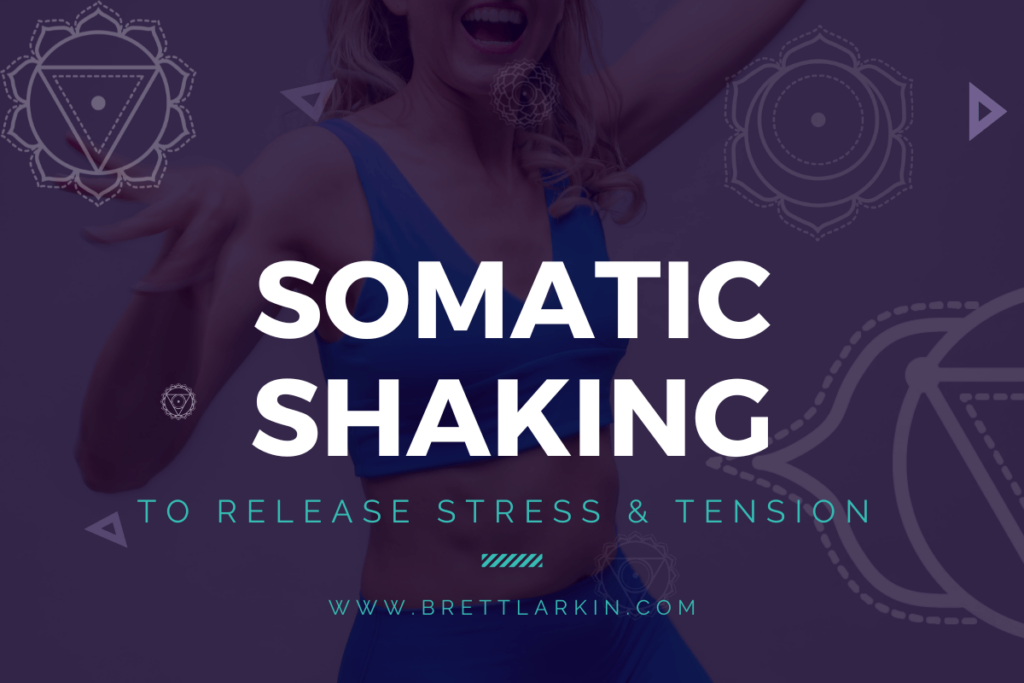Do you have a pet? A cat? A dog? If so, you probably feed it regularly, love it unconditionally and make sure it gets what it needs to thrive.
But did you know that you’re also the owner of another pet?
It’s called YOUR BODY. Your body is an animal. And it’s freaking out more than you realize.
You may have noticed that after dogs fight or birds get in a kerfuffle, they shake.
But when was the last time you did that?
Trauma is stored in the mind AND body. What we don’t express, we repress.
Tension in your shoulders, tightness in your jaw, shallow breathing—these aren’t just random stress responses. They’re signs that your nervous system is operating in danger mode, even when you think you’re safe. Your “animal” can’t tell the difference between an email and a real threat.
Luckily, somatic exercises – like shaking – can reset your system and release stored tension.
What Is Somatic Shaking?

Somatic shaking is one of a few trauma releasing exercises that involves rhythmic, spontaneous movements of the body to release muscular tension and stress. It’s a natural response observed in animals and humans as a way to discharge excess energy, process intense emotions, close the stress cycle and reset the nervous system.
It’s why I include somatic shaking in almost every somatic workout I teach.
But first, let’s define this word “somatic.”
It simply means “of the body”.
Somatic therapy and practices are a body based therapy that focuses on relieving stress and improving mental health through releasing trapped energy in the body, especially stress and trauma.
Unless you create the time and space to release traumatic experiences, the body stores all your anxiety and tension, binding it in your connective tissue. Eventually, your body is exerting so much energy, suppressing emotion, that symptoms like depression, fibromyalgia, excess adrenaline, paranoid emotional states, or insomnia begin to surface.
I like to blend somatic movement, yogic breathing and music. The goal is not only to focus on your internal sensations, perceptions, and experiences – but to release trapped trauma from your fascia while having fun (FUN signals “safety.”)
Somatic shaking is probably THE most accessible way to release tension and reset your nervous system. You can do it anywhere.
YOU used to be very good at this natural response to discharge excess energy. Until society trained you out of your shaking reflex…
Neurogenic Tremors
To fully understand somatic shaking you need to understand what neurogenic tremors are.
Neurogenic tremors are a bodily reflex that occur after a stressful event, causing the body to shake. It is a part of your autonomic nervous system, meaning they happen naturally – just like breathing.
Something stressful happens and your ACTH hormone tells your body to secrete adrenaline. Your body then enters a freeze (“play dead”) stress response. Like a mouse that plays dead so the cat will get bored playing with it.
When the cat moves on, the “frozen” mouse who’s been playing dead will begin to shake. It does this to reset its muscles, but also its nervous system, signaling the body to secrete different chemicals.
Watch this video to see how this works in the wild:
Still confused? Here’s how I explained neurogenic tremors to my six year old:
“This shaking helps our bodies feel better after something scary happens. It helps let go of all the big feelings. When you shake, it’s your body’s way of saying “I’m okay now!”. It’s like a little dance our bodies do to feel better.”
We’re all born with this reflex, we’ve just suppressed it. Shaking after reading an upsetting email is socially unacceptable.
Nowadays, humans usually only experience neurogenic tremors coming out of surgery after being under anesthesia.
But the good news is you can simulate it with somatic shaking!
Somatic Healing Masterclass: Rewire Trauma, Reclaim Your Intuition (usually $67) FREE👇
FREE Feminine Form Embodied Yoga Masterclass (usually $67) Unleashing Pleasure + Intuitive Movement on the Mat

Benefits Of Somatic Shaking
Taylor Swift knew it all along. One of the best things you can do for your body and your nervous system is to simply 🎵 shake it off, shake it off🎵!
But beyond the song, let’s break down the benefits.
Somatic shaking can enhance your overall well-being on physical, emotional, and even spiritual levels.
Here’s how Somatic Shaking benefits you:
Stress reduction:
Shaking kickstarts your parasympathetic nervous system, promoting relaxation and reducing stress. Pair shaking with mindful movements, like somatic yoga, to really cut down on stress and anxiety.
Better emotional regulation:
Slow somatic exercises tune you into your body’s sensations and how you react to emotions. You become more aware of what safety feels like in your body. This awareness is key to healing. Equally important, somatic shaking boosts your emotional resilience; especially helpful for those dealing with PTSD, offering a safe way to express emotional responses.
Take my feminine energy quiz to get a recommended practice for balancing YOUR feminine energy 👇
Release of physical tension:
Shaking targets problem areas in the body, easing discomfort and improving flexibility. Research backs up that these kinds of body-centered practices can effectively reduce muscle tension and stiffness.
Increased energy flow:
When you shake, you clear energetic blockages and help balance your body. You might be stretching and meditating, but when was the last time you shook up all your chakras (like shaking a snowglobe). Somatic release techniques can revitalize your energy (prana), leaving you feeling more vibrant and rejuvenated, ready to take on the world!
Releases pent-up emotions:
If you’re pissed off, shaking will help you feel better quickly. It clears stagnant thoughts and feelings, promoting emotional balance. AKA – you will feel lighter!
Engaging in somatic therapy approaches will:
✅ Release trauma & held tension
✅ Lower blood pressure
✅ Promote relaxation on a cellular level
✅ Energize your subtle body
✅ Feel emotionally lighter
The best part?
You don’t need a somatic therapist or coach to get started.
You can start shaking anytime…
How To Do Somatic Shaking

Warning: You will feel silly the first time you do this.
The benefits are worth it. Your animal body needs this.
If Taylor Swift helps, turn her on.
Follow these steps to start incorporating shaking into your practice:
Somatic Shaking – A Step by Step Guide
I’m addicted to how incredible this makes me feel. So I incorporate somatic shaking in most somatic yoga classes I teach.
But most students look at me cross-eyed at first.
Here what to do:
- Get over the embarrassment. Try it by yourself with one of my videos like the one below to start. Turn on music if it helps.
- Start with your hands. Simply shaking the wrist forward and back or side to side or in a flicking motion. Side note: You can literally shake your hands or wrists anywhere. Maybe your partner just annoyed you, or traffic is causing the expletives to bubble up in your throat🤭. Shake it off through your hands.
- Let the shake move from the hand to the arm. Move the arm up and down as you flick it. As if you were trying to get water off of you.
- Switch from one arm to the other or, if you feel ready, shake and flick both arms. Move the arms in all different directions
- Bring the arms down and shake through the chest. Shimmy the shoulders from side to side as fast or as slow as feels good to you.
- Get the booty involved. You may find your hips naturally want to move now. Let them! Follow your body’s natural rhythm and start shaking the hips back and forth.
- Initiate the movement from your tailbone and get the whole spine involved!
- Shake each leg and ankle. Let the upper body slow down as you shift your weight onto one leg, lifting the other to shake. You don’t have to lift the leg very high to get it moving. This movement can be as big or small as you like. Get the ankle flopping around.
- Switch from one leg to the other. Let go and have fun!
- Go nuts! Now, if you feel up for it bring it all together and shake everything! Let your inner wild woman shine here.
- Emote and make noise. This is your time. Maybe it’s some gibberish, “oooaaahhh, deedeedee” or maybe primal noises like grunting. Whatever wants to come out, let it. We stay in the same “bodyset” and “vocal range” most of the time. Any time we can mix these things up can be really healing.
PRO TIP: If you or your students feel uncomfortable going through a full shaking practice, start small. Lie on your back, take your legs up to the sky and shake them like crazy. You have the floor to feel supported and held but can really let it rip.

Things to keep in mind:
💎 Begin with Gentle Movements to familiarize yourself with the sensation gradually increasing intensity as you become more comfortable.
💎 Focus on Your Breath to support the release of tension and maintain relaxation.
💎 Pay Attention to Sensations that arise, allow yourself to experience and process them fully.
💎 Cool Down Slowly after shaking to ease back into a calm state and integrate the release.
We’ve been conditioned NOT to shake, but you can turn that around right now. Join me for this class:
If you like these cues and want to learn more about how to teach somatic yoga check out my Somatic Yoga Course.
Somatic Release: What to Expect
When you do somatic therapy or a somatic shaking practice, you might experience somatic release. You might feel sensations like:
💫 Tension dissolving
💫 Muscles relaxing
💫 A profound sense of calm enveloping you.
💫 Tingling and/or warmth
💫 Sensation of energy flowing more freely.
In other somatic therapies like EMDR therapy and sensorimotor psychotherapy, the release might be more subtle but equally impactful.
Keep in mind, your body is an animal that does not speak the same language as the intellect.
Body time is waayyy slower.
For example: you get an email that aggravates you – your shoulders shrug up, stomach tightens and jaw clenches. This is your unconscious natural response to stress.
You respond to the email and in your mind it’s done and gone.
But your “animal body” is operating in its own way – your jaw is still clenched. You still have an upset stomach.
Your mind may think the stressor is gone, but your body hasn’t caught up yet, still swirling with stress hormones.
Saturating in stress hormones for too long has led to a lot of the modern health issues we didn’t see before: fibromyalgia, IBS, etc. Be patient with your body, you may feel a release right away, or it may take some time. Keep with the practice and trust the process.
Closing Thoughts
Your body is not a project, it’s a skittish horse that needs your love – to run free and shake. If you’re ready to deepen your practice and promote healing, join my Somatic Yoga Certification. I’ll show you practical tools to enhance your daily life and relationships through intuitive movement and somatic embodiment.
Next Steps
- Take a deep dive into embodiment and somatic yoga with my Somatic Yoga certification program.
- If you’re interested in practical kriya yoga as a way to improve your daily life and relationships, check out my Yoga for Self Mastery course.

FREE Embodied Yoga Workshop (usually $67) Somatic Techniques & Cord Cutting Ritual

YOU MIGHT ALSO LIKE
- 7 Top Somatic Yoga Books to Regulate Your Nervous System
- 5 Best Somatic Yoga Apps for Nervous System Regulation
- Top Somatic Coaching Programs And How To Choose One
- Somatic Yoga Workshop Ideas for Teachers
- Somatic Yoga for Cortisol Detox: A Gentle Path to Stress Relief and Nervous System Healing
- Gentle Somatic Yoga: Heal Chronic Pain, Release Trauma, and Reclaim Your Bod
- Somatic Meditation: A Body-Based Approach to Healing Stress, Anxiety, and Trauma
- Advanced Pelvic Floor Breathing: A Somatic Approach to Healing
- Somatic Yoga For Yoga Teachers: Everything You Need to Know in 10 Steps
- How Somatic Shaking Can Release Tension and Reset Your Nervous System
- Discover Somatic Pilates: Enhance Your Body Awareness and Flexibility
- Kundalini for Feminine Energy: Ignite Your Creative Power and Passion
- 6 Effective Somatic Yoga for Neck and Shoulders
- How to Teach Somatic Yoga: A Practical Guide for Instructors
- The Best Somatic Exercises for Grief: Find Healing Through Movement













